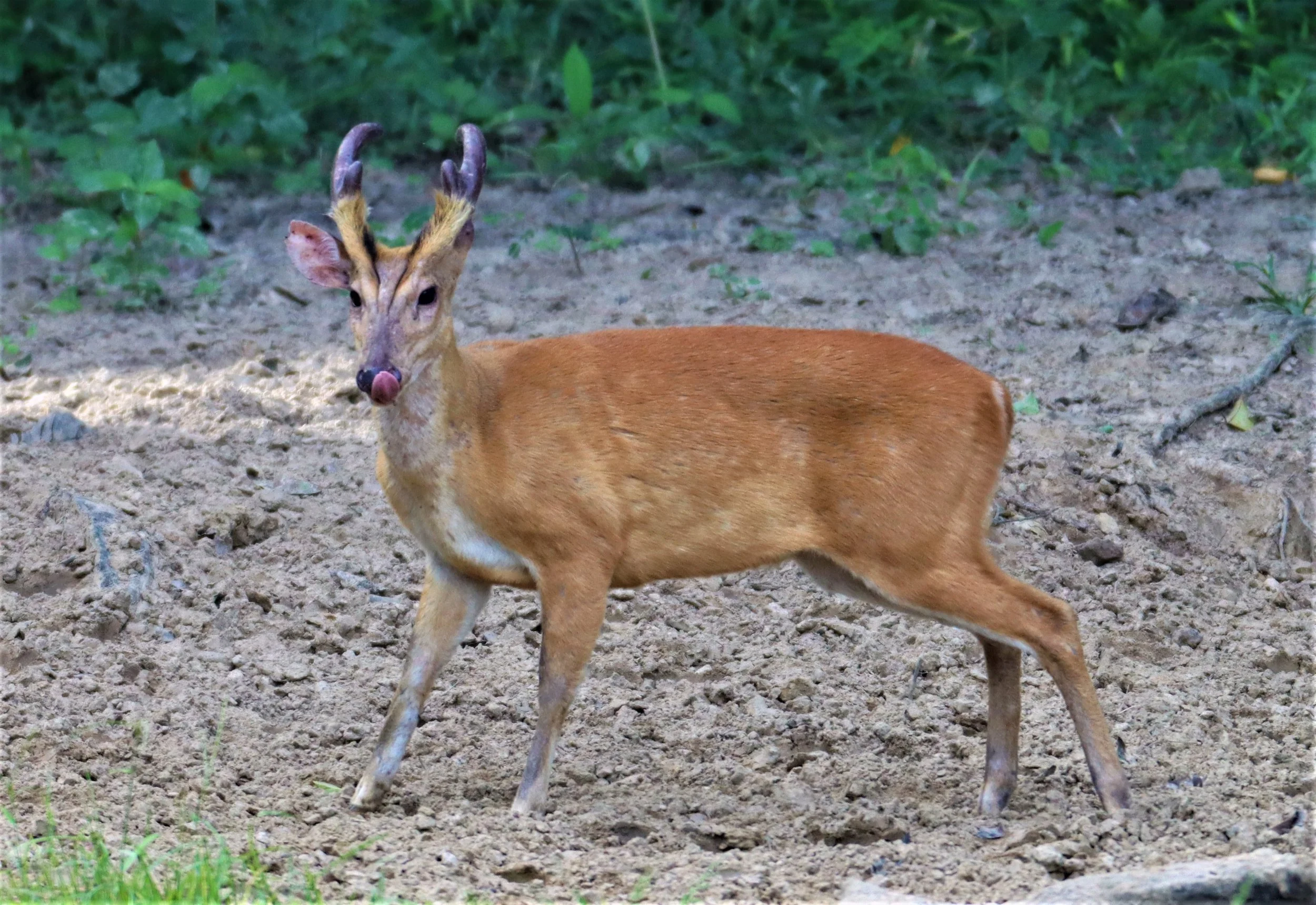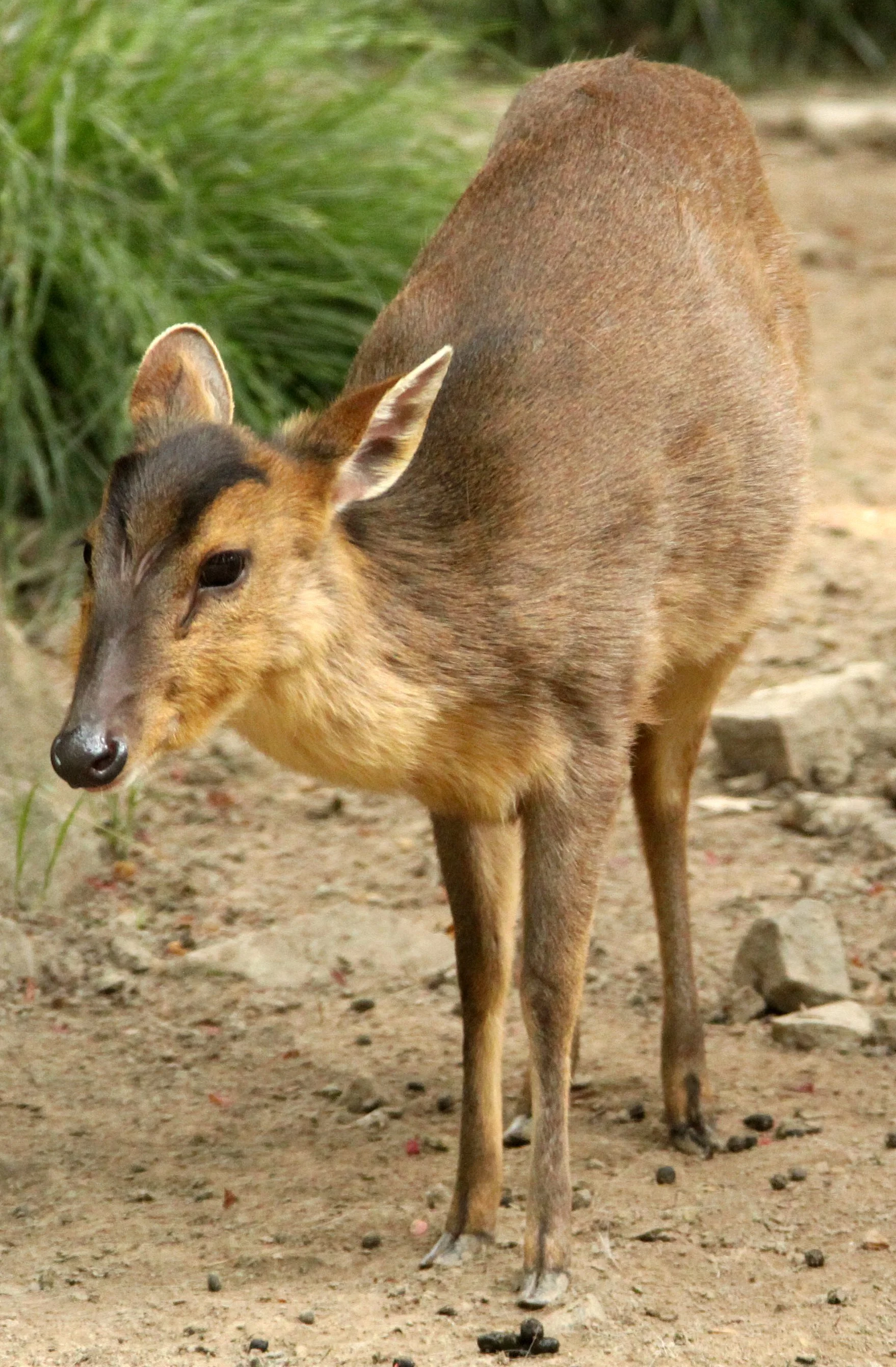
Tribe Muntiacini
Genus Elaphodus
Genus Muntiacus

The Tufted Deer (Elaphodus cephalophus) is a small species of deer characterized by a prominent tuft of black hair on its forehead and fang-like canines for the males. It is a close relative of the Muntjac, living somewhat further north over a wide area of central China and northeastern Myanmar. Suffering from overhunting and habitat loss, this deer is considered near-threatened. It is the only member of the genus Elaphodus.
Muntjacs, also known as the Barking Deer or Dib-faced Deer, are small deer of the genus Muntiacus native to South Asia and Southeast Asia. Muntjacs are thought to have begun appearing 15–35 million years ago, with remains found in Miocene deposits in France, Germany[3] and Poland.[4] Most species are listed as Least Concern or Data Deficient by the IUCN, although others such as the Black muntjac, Bornean yellow muntjac, and Giant muntjac are Vulnerable, Near Threatened, and Critically Endangered, respectively.
The following species are represented in this gallery:
Tufted Deer (Elaphodus cephalophus)
Fea's muntjac or Tenasserim muntjac (Muntiacus feae)
Red Muntjac (Muntiacus muntjak) with variou subspecies
Reeve’s Muntjac (Muntiacus reevesi)
Tufted Deer (Elaphodus cephalophus)
The Tufted Deer (Elaphodus cephalophus) is a small species of deer characterized by a prominent tuft of black hair on its forehead and fang-like canines for the males. It is a close relative of the muntjac, living somewhat further north over a wide area of central China and northeastern Myanmar. Suffering from overhunting and habitat loss, this deer is considered near-threatened. It is the only member of the genus Elaphodus.
Four subspecies of the tufted deer are recognized, with one having doubtful taxonomic status:
E. c. cephalophus – the largest subspecies, brownish coat, found in southwestern China and northeastern Myanmar.
E. c. michianus – has a relatively narrow snout, found in southeastern China.
E. c. ichangensis – has a relatively broad snout, with a grey-brown coat, found in Central China. (See below Gallery)
E. c. forciensus – doubtful subspecies, distribution unclear.
The tufted deer is similar to a muntjac in appearance, but the longer necks and legs give it a slightly leaner appearance. The coat is coarse with short and stiff hairs, being almost black in the winter and chocolate brown in the summer. The lips, tip of the ears, and the underside of the tails are white. A tuft of horseshoe-shaped hair is present on the forehead and upper neck, being brown to black, and can be up to 17 centimetres (6.7 in) long.
Perhaps the most striking feature of this deer is the fang-like canines in the males of the species. These can grow up to 2.6 cm (1.0 in) long, or longer in rare cases.
The tufted deer is a small deer, but still larger than most muntjac species. It stands at 50–70 centimetres (20–28 in) at the shoulder, and the weight varies from 17 to 30 kilograms (37 to 66 lb). The tail is short at around 10 cm (3.9 in). The antler is only present in males and is extremely short, almost hidden by its long tuft of hair.
The tufted deer is found mainly in China, where it occurs in the south from eastern coast to eastern Tibet. It is absent from the extreme south of the country. There are old records of this species in northeastern Myanmar, but recent surveys failed to find any, possibly due to the lack of surveys on the preferred habitat.
The tufted deer inhabits high, damp forests at 500–4,500 metres (1,600–14,800 ft) above sea level, close to the tree line. It is found in both evergreen and deciduous forests with extensive understory and nearby freshwater supply. The availability of salt licks is also a positive factor to the presence of this animal. This deer is able to withstand minor human disturbances, and is occasionally found in cultivated lands.
Central Chinese Tufted Deer (Elaphodus cephalophus ichangensis) - several seen in Tangjiahe National Park in Sichuan Province

Tufted Deer (Elaphodus cephalophus) Tangjiahe Nature Reserve, Sichuan China 2012
































Tufted Deer (Elaphodus cephalophus) Labahe Nature Reserve, Sichuan China 2024






























Fea's or Tenasserim muntjac (Muntiacus feae)
The Fea's muntjac or Tenasserim muntjac (Muntiacus feae) is a rare species of muntjac native to southern Myanmar and Thailand. It is a similar size to the common muntjac (adult weight is 18 – 21 kg (40 - 46 lb)). It is diurnal and solitary, inhabiting upland evergreen, mixed or shrub forest (at an altitude of 2500 m (8200')) with a diet of grasses, low-growing leaves, and tender shoots. The young are usually born in dense vegetation, remaining hidden until able to travel with the mother.
It is named after zoologist Leonardo Fea. Its other name comes from the Tenasserim Hills, between Burma and Thailand.
Fea’s Muntjac (Muntiacus feae) - seen at higher elevations in Kaeng Krachan National Park Thailand



















Indian or Common Muntjac (Muntiacus muntjak)
The Indian muntjac or the common muntjac (Muntiacus muntjak), also called the southern red muntjac and barking deer, is a deer species native to South and Southeast Asia. It is listed as Least Concern on the IUCN Red List. In popular local language, it is known as Kaakad or Kakad (काकड़)
This muntjac has soft, short, brownish or grayish hair, sometimes with creamy markings. It is among the smallest deer species. It is an omnivore and eats grass, fruit, shoots, seeds, bird eggs, and small animals, and occasionally scavenges on carrion. Its calls sound like barking, often when frightened by a predator, hence the common name "barking deer". Males have canines, short antlers that usually branch just once near the base, and a large postorbital scent gland used to mark territories.
The species was formerly classified as Cervus muntjac.
The Indian muntjac has a short but very soft, thick, dense coat that is more dense in cooler regions. Its face is darker and the limbs are dark to reddish brown and the coat color seasonally varies from darker brown to yellowish and grayish brown and is white ventrally. Its ears have much less hair, but otherwise are the same color as the rest of the head. Male muntjacs have short antlers, about 10 cm (3.9 in) long, that protrude from long body hair-covered pedicels above the eyes. Females have tufts of fur and small bony knobs instead of antlers. Males also have elongated (2–4 cm (0.79–1.57 in)), slightly curved upper canines, which can be used in male-male conflicts and inflict serious injury. The body length of muntjacs varies from 89–135 cm (35–53 in), with a 13 to 23 cm (5.1 to 9.1 in) long tail, and shoulder height ranging from 40 to 65 cm (16 to 26 in). Adult weight ranges between 13 to 35 kg (29 to 77 lb), with males being larger than females. Muntjacs are unique among the deer, having large, obvious facial (preorbital, in front of the eyes) scent glands used to mark territories or to attract females. Males have larger glands than females.
The Indian muntjac is among the most widespread, but least known of all mammals in South Asia. It is found in Bhutan, Bangladesh, southern China, northeastern India, Sri Lanka, Nepal, Pakistan, Cambodia, Vietnam, the Malay Peninsula, the Riau Archipelago, Sumatra, Bangka Island, Belitung, Java, Bali, and Borneo.[10] It is found in tropical and subtropical deciduous forests, grasslands, savannas, and scrub forests, as well as in the hilly country on the slopes of the Himalayas, at altitudes ranging from sea level up to 3,000 m (9,800 ft). They never wander far from water.
M. muntjac is a terrestrial mammal. A close survey of its microhabitat on Hainan Island was conducted from 2001 to 2002 by tracking with radio collar the localities of three females and two males. Results showed a favoritism towards shrub grassland, thorny shrub land, and dry savanna over woods, cultivated grass plots, and deciduous monsoon forests. Food availability was higher at foraging sites than at bed sites, but bed sites had taller and denser vegetation. No significant difference in wet vs dry was found in food abundance, so habitat selection seemed to be based upon maximum tree height and canopy diameters.
Ornithodoros indica has been recorded to be a parasite of the Indian muntjac, but it does not likely influence the distribution of this deer.
Distribution of subspecies
M. m. aureus in India
M. m. curvostylis in Khao Yai National Park
male M. m. malabaricus in Kandy
There are 15 subspecies (the below are the ones I have seen or photographed in the wild):
M. m. annamensis, Indochina
M. m. aureus, peninsular India
M. m. curvostylis, Thailand
M. m. malabaricus, South India and Sri Lanka
M. m. nainggolani, Bali and Lombok Islands
M. m. peninsulae, Malaysia
The Indian muntjac is also called "barking deer" due to the bark-like sound that it makes as an alarm when danger is present. It is also called Kakar. Other than during the rut (mating season) and for the first six months after giving birth, the adult Indian muntjac is a solitary animal. Adult males in particular are well spaced and marking grass and bushes with secretions from their preorbital glands appears to be involved in the acquisition and maintenance of territory. Males acquire territories that they mark with scent markers by rubbing their preorbital glands (located on their face, just below the eyes) on the ground and on trees, scraping their hooves against the ground, and scraping the bark of trees with their lower incisors. These scent markers allow other muntjacs to know whether a territory is occupied or not. Males often fight with each other over these territories, sufficient vegetation, and for primary preference over females when mating using their short antlers and an even more dangerous weapon, their canines. If a male is not strong enough to acquire his own territory, it will most likely to fall victim to a predator. During the time of the rut, territorial lines are temporarily disregarded and overlap, while males roam constantly in search of a receptive female.
Predators of these deer include tigers, leopards, clouded leopards, pythons, crocodiles, dholes, wolves, Indian pariah dogs, bears, fishing cats, jungle cats, Asian golden cats, golden jackals and striped hyenas.[8] Foxes, raptors and wild boars prey on fawns. They are highly alert creatures. When put into a stressful situation or if a predator is sensed, muntjacs begin making a bark-like sound. Barking was originally thought of as a means of communication between the deer during mating season, as well as an alert. However, in more recent studies, it has been identified as a mechanism used solely in alarming situations meant to cause a predator to realize that it has been detected and move elsewhere or to reveal itself. The barking mechanism is used more frequently when visibility is reduced and can last for over an hour regarding one incident. Muntjacs exhibit both diurnality and nocturnality.
Red Muntjac (Muntiacus muntjak curvostylis) - seen and documented in many locations in Thailand

Muntiacus muntjak curvostylis - Red Muntjac - Khao Yai NP Thailand














































































Muntiacus muntjak curvostylis - Red Muntjac - Khaeng Krachan NP Thailand July 2024













































Muntiacus muntjak curvostylis - Red Muntjac - Khao Yai NP Thailand July 2024

















Muntiacus muntjak curvostylis - Red Muntjac - Khao Yai NP Thailand July 2024
Indian Muntjac (Muntiacus muntjak aureus) - Bandhavghar India













Bali Red Muntjac (Muntiacus muntjak nainggolani) - Bali Barat National Park vicinity



Reeves's Muntjac (Muntiacus reevesi)
Reeves's Muntjac (Muntiacus reevesi; Chinese: 山羌), also known as the Chinese muntjac, is a muntjac species found widely in southeastern China (from Gansu to Yunnan) and Taiwan.[3] It has also been introduced in Europe, western United States and Japan. It takes its name from John Reeves, a naturalist employed by the British East India Company in the 19th century.
Reeves's muntjac feeds on herbs, blossoms, succulent shoots, fungi, berries, grasses, and nuts, and has also been reported to eat tree bark. Eggs and carrion are eaten opportunistically. It is also called the barking deer due to its distinctive barking sound, though this name is also used for other species of muntjacs. The barking sound is common during mating or when provoked. Its preferred habitats are forest and shrubland. It is a solitary and crepuscular animal. Both males and females defend small territories that they mark with preorbital gland secretions that are thought to be pheromonal in nature. When fighting, males first use their antlers to push enemies off balance so they can wound them with their 2 in (5.1 cm) upper canine teeth.
Female muntjacs (known as "does") become sexually mature within the first year of life. Mating occurs throughout the year. Their gestation period lasts from 209 to 220 days. Females limit the number of mating bouts, though time between successive bouts is determined by males (known as "bucks"
It is found widely in southeastern China (from Gansu to Yunnan) and Taiwan. It has also been introduced in several other regions.
Continental Europe
It has been introduced in Belgium and the Netherlands. In Europe, this species is included since 2016 in the list of Invasive Alien Species of Union concern (the Union list). This implies that this species cannot be imported, bred, transported, commercialized, or intentionally released into the environment in the whole of the European Union.
Great Britain
Reeves's muntjacs were first introduced to the UK in the early 19th century. In the late 19th century, the then Duke of Bedford brought some to Woburn Abbey in Bedfordshire, then in 1901 released them into the surrounding woods. A few more probably escaped from the nearby Whipsnade Zoo. During the mid-20th century, Woburn conducted several deliberate releases in distant locations throughout England. It is suspected that there were also other unrecorded releases or escapes from private collections. These releases later caused misperception that muntjacs spread very rapidly. The estimated population of Reeves's muntjacs in England was 52,000 in 1995, and 104,000 in 2008.
Under the Wildlife and Countryside Act 1981 it was illegal to release the species except where already established, and the Invasive Alien Species (Enforcement and Permitting) Order 2019 has subsequently prohibited the capture and re-release of muntjac in all cases. As of 2017, colonies exist throughout England south of Derbyshire, and the population continues to grow.
Reeve’s Muntjac (Muntiacus reevesi) - Tangjiahe Reserve, Sichuan China

Reeves's Muntjac (Muntiacus reevesi) Tangjiahe National Nature Reserve, Sichuan China 2012
















Reeves's Muntjac (Muntiacus reevesi) Tangjiahe National Nature Reserve, Sichuan China 2024









































